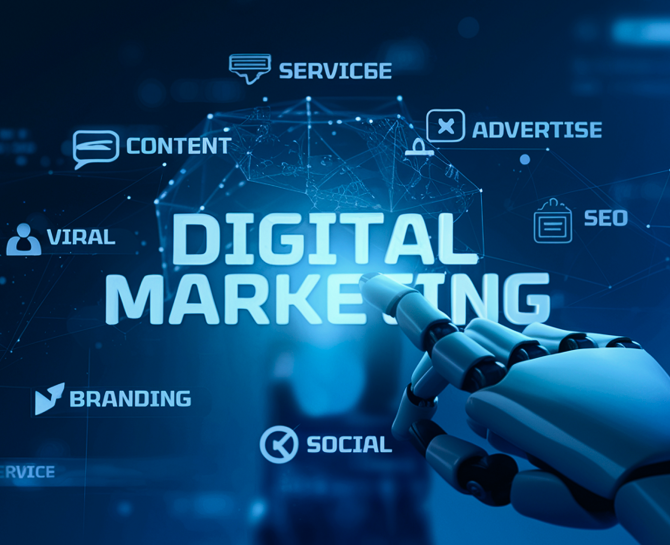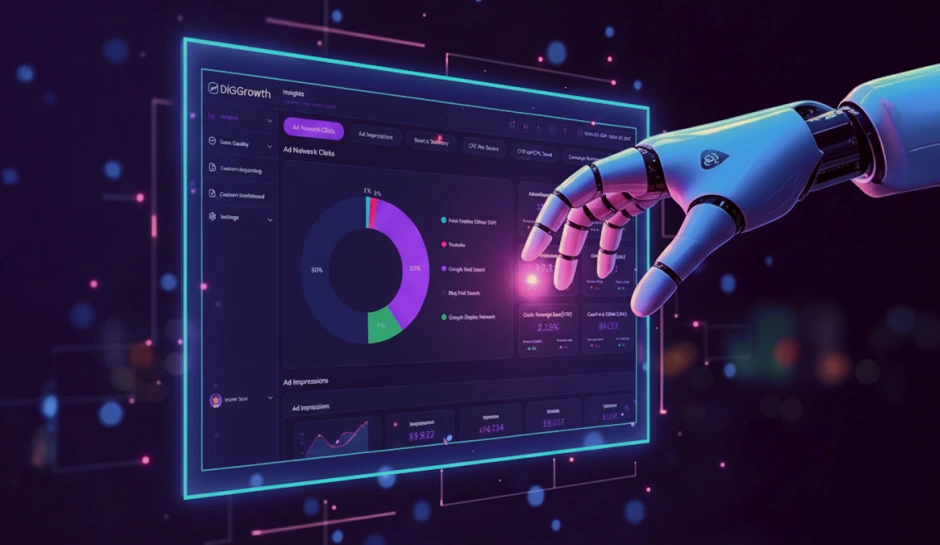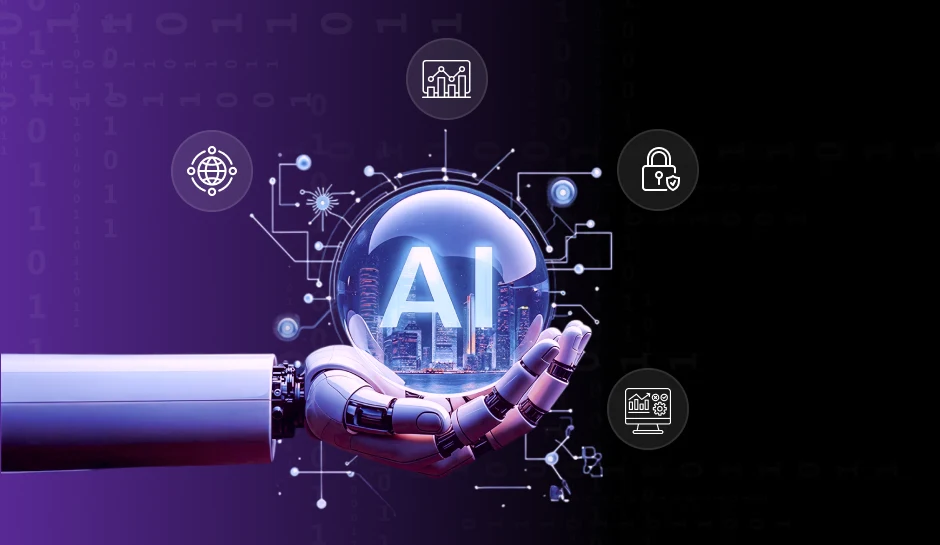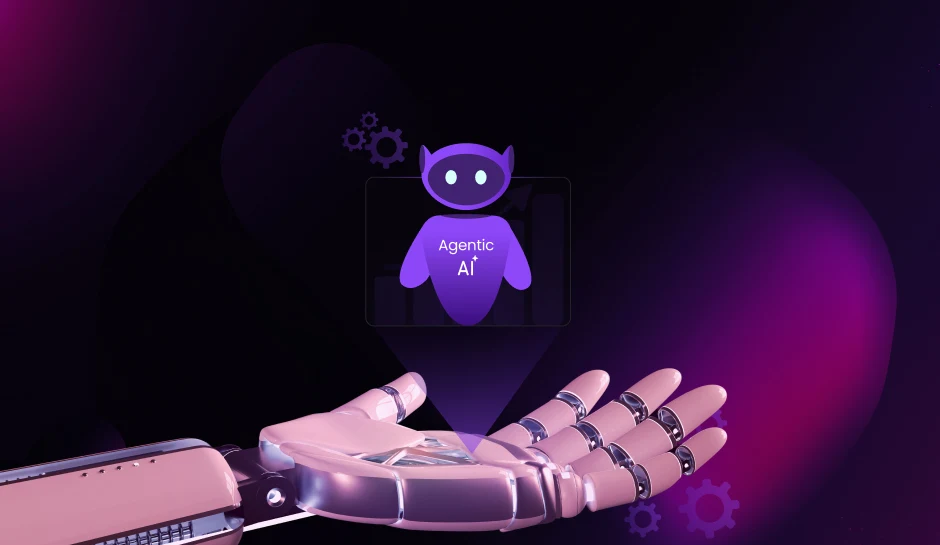
Redefining The Use of AI for Digital Marketing Strategy: From Data Insights to Dynamic Optimization
AI for digital marketing strategy is revolutionizing how brands understand and engage their audiences, transforming static campaigns into intelligent, responsive systems. From hyper-personalized content and predictive lead scoring to automated campaign orchestration and real-time customer journey mapping, AI empowers marketers to deliver precision at scale. This in-depth guide explores how AI for digital marketing turns raw data into actionable insights, accelerates performance across every touchpoint, and drives measurable growth in today’s competitive landscape.
Artificial Intelligence now shapes every layer of digital marketing strategy, from targeting and segmentation to content creation, personalization, and performance analytics. As consumer expectations evolve and marketing channels grow more complex, relying solely on intuition or static campaigns no longer delivers results. Success now depends on data-driven decision-making that responds in real time, powered by algorithms capable of detecting patterns faster than any human team.
AI tools today go far beyond automation. They decode behavioral trends, predict customer intent, and fine-tune campaigns with precision. Platforms like Google Performance Max and Adobe Sensei provide marketers with actionable AI-driven insights, while technologies such as machine learning models fuel predictive analytics and dynamic pricing strategies. Marketers who integrate these systems outperform those who don’t, measurably and repeatedly.
In this post, we explore how AI is reshaping core marketing functions, what leading platforms deliver in terms of capability, and how to build an AI-powered strategy that accelerates performance across the customer journey.
Refining Precision: Customer Segmentation and Targeting with AI
Strategic Segmentation Starts with Intelligence
Customer segmentation divides a business’s audience into distinct groups based on shared characteristics. Traditional segmentation utilizes categories such as age, gender, location, and purchase history. In strategic marketing, precise segmentation ensures that messaging, product recommendations, and offers align with the needs and behaviors of specific customer clusters. Segmentation done correctly drives ROI, reduces waste in ad spend, and improves customer lifetime value.
AI-Powered Clustering: Beyond Basic Demographics
Artificial Intelligence pushes customer segmentation far beyond static categories. Machine learning models analyze massive datasets-including transaction histories, browsing patterns, social media activity, customer service interactions, and time-on-site behavior. With unsupervised learning techniques such as k-means clustering or hierarchical clustering, AI identifies latent patterns in consumer behavior that humans often overlook
- Demographics:
- Psychographics:
- Engagement:
- Time-Based Trends:
AI can refine age, income, and geographic data by layering in trend detection and contextual inference.
Natural Language Processing (NLP) mines sentiment and intent from content interaction, reviews, and social media posts.
Behavioral clustering reveals differences between frequent browsers, one-time buyers, loyal customers, and high-potential prospects.
Sequence modeling tracks activity over time, enabling segmentation based on the progression of lifecycle stages.
Hyper-Targeted Campaigns in Practice: The North Face
The North Face partnered with IBM Watson to implement AI-driven segmentation across its e-commerce and mobile platforms. Using NLP and behavior-tracking algorithms, the system grouped users based on their climate preferences, past purchases, and travel habits. A customer planning a hiking trip in Alaska received gear suggestions tailored for extremely cold conditions. Meanwhile, a user searching for weekend escapes in California saw lightweight jackets and portable accessories.
This laser-focused targeting produced measurable results: conversion rates increased by over 60% compared to control groups, while returning visitor engagement improved markedly. AI made it possible to serve more relevant content without relying on manual tagging or static personas.
Segmentation isn’t just cleaner with AI- it’s dynamic. Every interaction updates customer profiles in real-time, enabling campaigns that evolve in tandem with user behaviors. Who gets included in which segment isn’t determined once-it’s recalculated continuously, tightening feedback loops and keeping content relevant at every touchpoint.
Pro Tip- To maximize the impact of AI-powered segmentation, integrate your customer data platform (CDP) with real-time analytics tools and marketing automation systems. This allows your AI models to continuously refine audience clusters and trigger hyper-personalized campaigns as behaviors shift, ensuring you’re always targeting the right customer, with the right message, at the right moment.
Conversational AI: Chatbots and Virtual Assistants
From Live Agents to Seamless Automation
24/7 responsiveness is no longer a perk- it’s expected. Conversational AI systems, driven by natural language processing (NLP) and machine learning algorithms, are now handling interactions traditionally managed by human agents. These systems don’t sleep, take no breaks, and never miss inquiries. Businesses that deploy AI-powered chatbots and virtual assistants can scale their customer support and engagement without incurring additional operational costs.
The shift toward automation stems from a clear return on investment (ROI). According to Juniper Research, by 2023, chatbots were projected to save banking, healthcare, and retail sectors over $11 billion annually in operational costs. The impact? Reduced wait times, improved user satisfaction scores, and higher conversion rates.
Operational Use Cases: Lead Capture, Support, and Insights
Digital marketers are integrating conversational AI into core workflows for three strategic purposes:
- Lead Qualification and Nurturing: AI chatbots initiate conversations on landing pages, quickly determining prospect intent through contextual questions. For example, Drift’s chatbot platform integrates with CRM systems to instantly route sales-qualified leads to human representatives.
- Customer Support at Scale: Platforms like Intercom and Zendesk use AI agents to provide instant answers to FAQs. These bots resolve volume-heavy queries, such as shipping information or policy clarifications, freeing up human agents for more complex tickets.
- Behavioral Data Collection: Every chatbot interaction becomes a data point. From the way a question is phrased to the time taken to respond, AI systems aggregate this data to optimize messaging, predict intent, and refine buyer personas.
Smart use of conversational AI turns passive inquiry into active conversion. Chatbots don’t wait for users to complete forms- they initiate dialogue based on behavior triggers. Exit-intent popups, scroll-depth tracking, and delayed-response re-engagement are just a few ways to reignite user interest and reduce bounce rates.
Automating Campaigns Through AI-Powered Marketing Automation
Unlocking Operational Efficiency Through Automation
AI eliminates manual bottlenecks by automating routine marketing tasks. Workflow automation platforms, such as HubSpot, Salesforce Einstein, and ActiveCampaign, integrate machine learning to streamline campaign setup, segmentation, content deployment, and performance tracking. Marketers reduce time spent on repetitive execution and shift resources to strategic planning.
Repetitive functions, such as segment updates, triggered emails, and behavioral tracking, operate continuously in the background. AI models adapt in real-time, refining processes as new data flows in. Marketo’s State of Marketing Automation report (2023) revealed that automated systems reduce campaign deployment time by an average of 28%, compressing launch cycles from weeks to days.
Trigger-Based Campaigns and Intelligent Scoring in Action
Events, such as webpage visits, cart abandonment, or email opens, can trigger precise, automated responses. AI identifies behavioral signals and assigns lead scores using predictive algorithms, considering over a dozen behavioral and demographic variables.
Trigger engagements based on dynamic actions-abandoning a browsing session can prompt a custom discount email within minutes.
- Score leads intelligently using AI-driven models trained on historical conversion data-manual scoring lacks this statistical evolution.
- Prioritize contacts by likelihood to convert rather than list position or last interaction date.
- This reactive capability aligns content delivery with the customer journey. For example, Salesforce reports a 52% higher open rate for emails triggered by AI-recognized behavior patterns compared to those sent traditionally
Strategic Depth and Scalable Execution
AI-powered automation doesn’t just optimize workflows- it scales campaign volume without diluting targeting precision. A mid-sized team, limited in bandwidth, can orchestrate hundreds of concurrent micro-campaigns tailored to segmented audiences.
Combine that with adaptive machine learning, and each campaign iteration becomes sharper than the last. As models ingest more performance data, strategic alignment becomes increasingly important. Predictive insights from early campaign interactions enable real-time pivoting, adjusting budget allocation, shifting audience parameters, or deploying alternative creatives at scale.
Pro Tip- Leverage AI-driven A/B testing within your marketing automation platform to not only optimize subject lines or send times, but to dynamically test entire content flows based on real-time engagement. Let the AI determine the most effective combinations of creative, timing, and channel for each micro-segment—scaling smarter, not just faster.
AI-Powered SEO and Content Strategy
Decoding Search Intent with AI
AI-driven SEO tools don’t just check for keyword density- they dissect user behavior, query patterns, and contextual language to understand what the searcher truly wants. Natural Language Processing (NLP) engines, such as Google’s BERT and OpenAI’s GPT-class models, analyze search queries to identify underlying intent, allowing marketers to craft content that directly addresses informational, navigational, or transactional purposes. This alignment increases dwell time and reduces bounce rates, two key ranking signals that positively impact search engine rankings.
Keyword Opportunities and Competitive Advantage
Machine learning platforms ingest vast datasets from search engine results pages (SERPs), backlink profiles, and competitor content to surface untapped keywords and latent topic opportunities. Tools like Clearscope, MarketMuse, and Semrush use AI to map existing content against high-performing pages across industries, identifying missing semantic terms and underrepresented subtopics.
- Keyword clustering: AI groups related queries together to map comprehensive topic clusters.
- Content gap analysis: Platforms detect areas your site fails to cover compared to competitors’ rankings for the same terms.
- Competitive movement tracking: Dynamic algorithms highlight keyword ranking shifts across domains, revealing where competitor content either succeeds or loses ground.
Marketers implementing these AI insights don’t guess the next blog topic- they choose it based on behavioral, linguistic, and performance signals across their industry niche.
Evaluating Content Quality with AI-Driven Scoring Tools
Content scoring platforms powered by AI evaluate articles based on readability, topicality, emotional tone, and authority signals. MarketMuse, Surfer SEO, and Frase assign benchmark scores tied to the top-ranking results, providing editorial guidelines that help underperforming content move closer to the SERP leaders.
For example, MarketMuse uses machine learning models trained on high-performing web pages to tell you exactly what concepts and depth are required to compete. Tools like Grammarly and Hemingway Editor integrate user behavior data to refine readability and writing clarity-two critical contributors to both user satisfaction and SEO rankings.
The correlation between high content scores and first-page ranking is no longer anecdotal. A 2023 study by Backlinko found that among 11.8 million Google search results, pages with higher topical coverage (measured by AI tools) were significantly more likely to rank in the top three positions.
Pro Tip- Before creating new content, run AI-powered audits on both your existing pages and top-ranking competitor content. Use the insights to build comprehensive topic clusters, enhance semantic depth, and improve readability, ensuring every piece you publish is optimized not just for keywords, but for searcher intent and user experience.
Voice Search and the Growing Role of AI in Voice Optimization
How Voice Search is Changing Consumer Behavior
Smart speakers and voice-enabled assistants have redefined how people access information. Over 50% of U.S. adults use voice search daily, according to NPR and Edison Research. This behavioral shift isn’t limited to quick weather checks or timer settings- people now shop, research, and discover brands through spoken queries. Phrasing has also changed: users are more conversational, asking complete questions instead of typing fragmented keywords.
This evolution has significant implications for digital marketers. Search queries are now longer, more context-driven, and often localized. For example, instead of typing “coffee shop Boston,” a user might say, “Where’s a good coffee shop near Boston Common that’s open now?” Each word adds complexity and intent- a goldmine for marketers using AI.
Using AI to Optimize for Voice
Traditional search optimization doesn’t cut it anymore. To align with voice-first behavior, content must match how people speak. AI tools leverage machine learning and natural language processing (NLP) to bridge the gap between written content and spoken search queries. These tools analyze millions of spoken user intents, extract question-based patterns, and recommend optimized phrasing.
- AI-generated content engines can create FAQ-rich landing pages that mirror how consumers ask questions in real life.
- Voice intent recognition platforms parse long-tail queries and suggest semantic clusters for better targeting.
- Machine learning algorithms identify search trends across demographics and geolocations to inform content calendars.
These technologies enable the scaling of voice-optimized content production while maintaining precision and relevance.
Boosting Visibility with Structured Data and NLP
Answer boxes and featured snippets dominate voice results. To qualify, content must be structured in a way that is readable by machines. AI enhances this process by implementing automated schema markup. By tagging product details, business hours, locations, and other metadata, AI enhances the likelihood that content will be selected as a voice assistant’s spoken response.
Natural language processing takes it further. NLP-driven AI rewrites or refines content to ensure it aligns syntactically and semantically with real user queries. It removes ambiguity, enhances readability, and boosts compatibility with voice algorithms used by platforms like Google Assistant and Amazon Alexa.
Search engines favor clear intent, structured answers, and natural flow. By combining schema markup and NLP with machine learning insights, digital teams can create content that not only ranks but speaks.
Pro Tip-When optimizing for voice search, structure your content to answer specific, conversational questions. Use AI to surface long-tail query data and apply schema markup to FAQs, how-tos, and local business details. This not only boosts your chances of landing in featured snippets but also increases visibility in voice-first environments like smart speakers and mobile assistants.
AI and Customer Journey Mapping: From Touchpoints to Transformation
Visualizing the Full Spectrum of Customer Behavior
Traditional funnel-based models offer only fragmented glimpses into the customer journey. AI changes this. By processing millions of interactions across various platforms, mobile apps, websites, email, social media, and CRM systems, AI constructs a comprehensive, real-time view of how individuals engage with a brand, from initial touch to post-purchase behavior.
Using AI-driven customer journey analytics, marketers uncover nonlinear paths that lead to conversion. For example, Google’s analytics platform utilizes machine learning models, such as the Markov Chain Attribution model, to assess the actual impact of each channel in user paths. Instead of guessing whether PPC, email, or organic traffic deserves primary credit, these models assign incremental value based on probability data. This kind of insight is not accessible through manual mapping.
AI Unifies Disparate Data to Reveal Actionable Narratives
Customer data lives in silos-clickstream data in analytics platforms, purchase data in ERP systems, and chatbot interactions scattered across third-party software. AI consolidates it. Through machine learning algorithms and natural language processing techniques, this fragmented input transforms into coherent user journeys.
For example, customer data platforms (CDPs) powered by AI link behavioral signals, past purchases, demographic attributes, and engagement patterns into unified customer profiles. Adobe Real-Time CDP and Salesforce Einstein use AI layers on top of CDPs to recognize journeys, identify intent shifts, and detect churn signals before they materialize.
Sharper Campaign Timing and Journey Precision
Campaign success hinges on knowing the right moment to engage. AI pinpoints that moment. Such systems analyze historical customer interaction data to identify when users are most likely to open emails, visit product pages, or complete purchases. Then they automate precisely timed triggers.
Utilize dynamic journey orchestration engines, such as Oracle Infinity or SAS Customer Intelligence 360. These platforms monitor customer behavior in real-time and recalibrate campaign flows when drop-offs, hesitations, or surges in interest occur. Marketers no longer rely on fixed flowcharts-instead, AI reshapes the journey as each user behaves uniquely.
Hyper-Personalized Experiences Through Journey Analysis
Tailored content must align with the specific stage of the journey. AI ensures this alignment by analyzing context. A user bouncing repeatedly on product pages but not adding to the cart? AI suggests objection-handling nudges. Has someone recently been engaging with pricing tiers? AI serves comparative reviews or testimonials. These decisions are algorithmically driven, not rule-based.
- Sentiment-crossed journey triggers: AI tools like IBM Watson detect emotional tone from CRM notes or chatbot transcripts and integrate this data into journey mapping.
- Real-time adaptive web content: Platforms such as Dynamic Yield swap modules of a webpage dynamically based on user behavior within milliseconds.
- Journey scoring systems: AI assigns predictive scores to user journeys using survival models or recurrent neural networks to forecast likely next actions.
By layering these functionalities, AI doesn’t just track journeys- it shapes them toward richer, more personalized outcomes.
Pro Tip- Use AI-powered journey orchestration tools not only to react to customer behavior but to predict and preemptively shape it. Train your AI models with multi-source data, including sentiment analysis and lifecycle signals, to automate hyper-personalized nudges at just the right moment. This predictive capability transforms your customer journey from reactive to truly anticipatory.
From Data to Dominance: AI Insights That Redefine Digital Marketing Strategy
AI transforms every layer of a digital marketing strategy, unlocking a level of precision that traditional tools can’t match. Consider how AI dissects consumer behavior at scale to uncover real-time preferences. Or how it enables content personalization across thousands of customer journeys-simultaneously and efficiently.
Strategy Meets Intelligence
Digital marketing stops being guesswork when strategy is layered over data with dynamic AI tools at its core. Testing becomes constant, not episodic. Content reacts to user behavior instead of being locked in upfront. The entire customer journey, from discovery to loyalty, is mapped and refined through learning systems that adapt with every click, swipe, or dwell time metric.
Brands that integrate AI across the funnel aren’t just chasing metrics- they’re shaping outcomes. For instance, a global retailer that embedded AI across its marketing stack saw a 25% lift in customer retention and slashed acquisition costs by 18% within nine months. Strategic deployment, not just tool adoption, drove those results.
Key Takeaways
- Traditional segmentation is outdated. AI enables real-time, behavior-based audience clustering using vast datasets, ranging from demographics and psychographics to time-based interaction trends, allowing marketers to personalize messaging at an individual level.
- AI-powered chatbots and virtual assistants do more than automate support, they qualify leads, gather behavioral data, and trigger timely re-engagement, reducing bounce rates and lifting conversion rates without increasing human workload.
- From intelligent lead scoring to automated, behavior-triggered campaigns, AI eliminates manual bottlenecks. Marketers can now launch, adapt, and optimize campaigns in real-time, driving higher ROI and increased resource efficiency.
- With AI-enhanced content optimization and journey analysis, marketers can craft experiences aligned with true search intent and buyer behavior. These tools uncover not just what users do, but why, empowering strategic content delivery and predictive engagement.
Marketers scaling tomorrow’s brands are already using AI to design smartersystems, rewire creative workflows, and deliver outcomes that previously required guesswork.
Drop us a line at info@diggrowth.com to not only join but lead the walk.
Ready to get started?
Increase your marketing ROI by 30% with custom dashboards & reports that present a clear picture of marketing effectiveness
Start Free Trial
Experience Premium Marketing Analytics At Budget-Friendly Pricing.

Learn how you can accurately measure return on marketing investment.
Additional Resources
How Predictive AI Will Transform Paid Media Strategy in 2026
Paid media isn’t a channel game anymore, it’s...
Read full post postDon’t Let AI Break Your Brand: What Every CMO Should Know
AI isn’t just another marketing tool. It’s changing...
Read full post postFrom Demos to Deployment: Why MCP Is the Foundation of Agentic AI
A quiet revolution is unfolding in AI. And...
Read full post postFAQ's
AI moves beyond traditional demographic segmentation by analyzing real-time behavior, purchase history, sentiment, and engagement patterns. Using machine learning algorithms like clustering and sequence modeling, marketers can uncover micro-segments and dynamically update customer profiles, allowing hyper-targeted messaging at every stage of the buyer journey.
AI chatbots handle lead qualification, support, and engagement at scale. By analyzing user input in real time, they personalize responses, collect valuable behavioral data, and trigger tailored follow-ups. This reduces response time, improves conversion rates, and frees human reps to focus on high-value interactions.
AI automates repetitive tasks like lead scoring, email triggering, and audience segmentation, enabling marketers to focus on strategy. With behavior-based triggers and predictive insights, campaigns launch faster, adjust in real time, and drive higher open and conversion rates through precisely timed engagement.
AI tools optimize SEO by identifying search intent, surfacing content gaps, and recommending high-performing keywords and topics. Natural Language Processing (NLP) ensures content matches how users speak and search, while content scoring platforms evaluate readability, structure, and topical authority to improve SERP rankings.
AI consolidates data from multiple touchpoints to build real-time, end-to-end customer journey maps. It predicts next-best actions, detects churn signals, and enables automated, personalized experiences based on each user’s unique behavior. This transforms static journeys into responsive, high-impact engagement paths.


